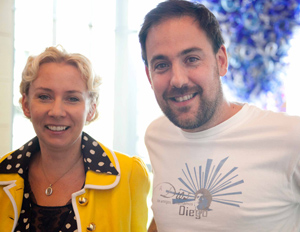October 22, 2012 - By Christopher Vaughan

Joanna Wysocka and Alvaro Rada Iglesias led a team that discovered how a collection of DNA sequences called "enhancers" can affect the activity of genes that govern the face's developmental process.
The human face is a fantastically intricate thing. The billions of people on the planet have faces that are individually recognizable because each has subtle differences in its folds and curves. How is the face put together during development so that, out of billions of people, no two faces are exactly the same?
School of Medicine researcher Joanna Wysocka, PhD, and her colleagues have discovered key genetic elements that guide the earliest stages of the process.
Their research, published in the Sept. 13 issue of Cell Stem Cell, provides a resource for others studying facial development and could give insights to the cause of some facial birth defects. Because there is not enough genetic information in the body to define exactly where each cell will go, development of the face proceeds much like origami: genes provide instructions for folding, crimping, and movement of cells. As with origami, following a sequence of simple instructions can result in a complex, intricate object.
Wysocka focused on the first critical fold in the process of making an embryo, when the whole of the embryo is a flat sheet of cells that creases and closes over on itself to make a tube. Much of the tube eventually becomes the foundation of the brain and the spinal column, but one end sets the stage for the formation of the head and face. This process is driven by a small population of remarkable cells called neural crest cells.
"We were interested in identifying the portions of the human genome that are responsible for the behavior of the neural crest," Wysocka said.
What they discovered is that the modification of a collection of DNA sequences called "enhancers" can dial up or down the activity of the genes governing which cells eventually become the face. It's almost as if they have discovered how the instructions for a piece of origami can be modified — slightly change how a fold is made and you may end up with something very different looking.
Of particular interest is that although these enhancers affect how genes function, enhancers are not genes nor are they always near the genes they affect. Enhancers exist in the vast non-coding regions of the genome that people used to call "junk DNA," but which is now proving important in genetic function. The enhancers can be silent or active, depending on where a cell is and at what stage it is in the development of the embryo.
"What's really emerging is the idea that one cell type's junk is another cell type's treasure," said Wysocka.
What's useful about their discoveries is that that researchers will now know much better where to look for the causes of disorders of facial development, such as cleft lip or cleft palate. In these disorders, sheets of cells from opposite sides of the face do not fuse fully during development, leaving a cleft or gap. "By identifying neural crest enhancers, our study can tell other investigators where to look for genetic variants that can explain these facial abnormalities or even why each human being has a unique face," said Alvaro Rada Iglesias, PhD, who is the first author on the paper and a member of the Wysocka laboratory.
Although only a handful of enhancers were already shown to be important in regulating early neural crest development, research by Wysocka and her colleagues has produced thousands of such enhancers that are active in determining the behavior of these cells. Moreover, this research showed that the information contained within those enhancers can be used to identify novel genes controlling neural crest and face formation."Our results will serve as a resource for other investigators," she said.
Wysocka expects that the usefulness of the data will extend far beyond facial development. By having the sequences of thousands of these enhancers, scientists can look at the kind of DNA patterns or "motifs" that are common in these enhancers and use that information to look for enhancers that regulate genes throughout development.
Other Stanford co-authors include former postdoctoral scholars Ruchi Bajpai, PhD, and Samantha Brugmann, PhD; graduate student Sara Prescott; and senior research scientist Tomek Swigut, PhD.
The research was funed by the National Institutes of Health, the Searle Scholars Program, the W.M. Keck Foundation, EMBO and the Siebel Scholars Program.
Christopher Vaughan is communications manager for the Stanford Institute for Stem Cell Biology and Regenerative Medicine.
About Stanford Medicine
Stanford Medicine is an integrated academic health system comprising the Stanford School of Medicine and adult and pediatric health care delivery systems. Together, they harness the full potential of biomedicine through collaborative research, education and clinical care for patients. For more information, please visit med.stanford.edu.